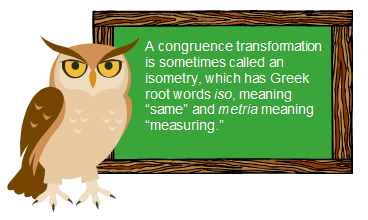

In the last section, you added rotations to your set of transformations, along with reflections, translations, and dilations. In this section, you will compare two different classes of transformations: (1)congruence transformations that generate an image that is congruent to the preimage and (2) non-congruence transformations that generate an image that is not congruent to the preimage. Specifically, you will use side lengths and angle measures to distinguish between which types of transformations are congruence transformations, and which types are not.
![]() Click the image below to open an interactive sketch in a new web browser tab or window. Use the interactive to investigate the relationships among side lengths and angle measures. Follow the detailed directions beneath the image to investigate each transformation.
Click the image below to open an interactive sketch in a new web browser tab or window. Use the interactive to investigate the relationships among side lengths and angle measures. Follow the detailed directions beneath the image to investigate each transformation.
Interactive popup. Assistance may be required.
The lengths of corresponding sides are the same, meaning that corresponding sides of a translated triangle are congruent.
Interactive popup. Assistance may be required.
The measures of corresponding angles are the same, meaning that corresponding angles of a translated triangle are congruent.
Interactive popup. Assistance may be required.
Yes. Since all pairs of corresponding sides are congruent and all pairs of corresponding angles are congruent, Δ ABC is congruent to Δ A'''B'''C'''.
Interactive popup. Assistance may be required.
The lengths of corresponding sides are the same, meaning that corresponding sides of a translated triangle are congruent.
Interactive popup. Assistance may be required.
The measures of corresponding angles are the same, meaning that corresponding angles of a translated triangle are congruent.
Interactive popup. Assistance may be required.
Yes. Since all pairs of corresponding sides are congruent and all pairs of corresponding angles are congruent, Δ ABC is congruent to Δ A'B'C'.
Interactive popup. Assistance may be required.
The lengths of corresponding sides are the same, meaning that corresponding sides of a translated triangle are congruent.
Interactive popup. Assistance may be required.
The measures of corresponding angles are the same, meaning that corresponding angles of a translated triangle are congruent.
Interactive popup. Assistance may be required.
Yes. Since all pairs of corresponding sides are congruent and all pairs of corresponding angles are congruent, Δ ABC is congruent to Δ A''B''C''.
![]() Use the interactive below to investigate side lengths and angle relationships for dilations. Use the slider to adjust the scale factor of the dilation, and drag point D to adjust the center of dilation. Use the interactive to answer the questions that follow.
Use the interactive below to investigate side lengths and angle relationships for dilations. Use the slider to adjust the scale factor of the dilation, and drag point D to adjust the center of dilation. Use the interactive to answer the questions that follow.
Properties of Dilations
OnTRACK for College Readiness, Created with GeoGebra |
Interactive popup. Assistance may be required.
The lengths of corresponding sides are not the same, but they are proportional.
Interactive popup. Assistance may be required.
The measures of corresponding angles are the same, meaning that corresponding angles of a translated triangle are congruent.
Interactive popup. Assistance may be required.
No. Since all pairs of corresponding sides are proportional and all pairs of corresponding angles are congruent, Δ ABC is similar to Δ A'B'C', but they are not congruent.
A congruence transformation is a transformation in which the preimage and image are congruent figures. Which transformation(s) are congruence transformations?

A non-congruence transformation is a transformation in which the preimage and image are not congruent figures. Which transformation(s) are non-congruence transformations?
Which transformations preserve angle measures between the preimage and the image?

Which transformations preserve side lengths between the preimage and the image?
Interactive popup. Assistance may be required.
Congruent figures have corresponding sides that are congruent and corresponding angles that are congruent. Congruence transformations preserve congruence between the preimage and image.
Interactive popup. Assistance may be required.
What type of transformation is indicated by (x, y) → (x − 4, y + 5)?
Interactive popup. Assistance may be required.
Translations, rotations, and reflections are congruence transformations. Which algebraic rules indicate one of these types of transformations?